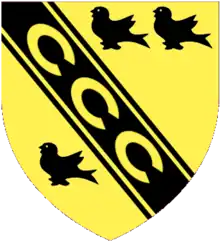Michael Lloyd Ferrar
Lieutenant-Colonel Michael Lloyd Ferrar CSI CIE OBE (16 April 1876 – 25 February 1971) was a British Indian army officer and civil servant who worked as a chief commissioner of the Penal Settlement at Port Blair on Andaman Islands and Nicobar Islands.
Born 1876, son of Michael Lloyd Ferrar, Ferrar was educated at St. Columba's College, Rugby and the Royal Military College, Sandhurst where he was a contemporary of Winston Churchill. He joined the Indian Army at the age of 20 in 1896 and served on the North West Frontier during the Tirah Campaign 1897-98. Ferrar opted to move to join the Home Department of the Government of India in 1901 [1] and was inducted into the Punjab Commission.[2] He studied Urdu, Punjabi, Baluchi and Pashto.[3]
Before becoming Commissioner of the Andaman and Nicobar Islands he served at various positions in northern and northwestern parts of British India. From 1902-1906 he commanded the Baloch Levy, was a postal censor at Bombay, 1915-18, and deputy commissioner Lahore, 1919-23, during which time he was involved in the arrest of Lala Lajpat Rai and Satyanand Stokes on charges of sedition.[4]
Ferrar was responsible for increasing agriculture on the Andamans. Under his management, tea, coffee and rubber were tried on the island and land was allotted to settlers between 1923 and 1926. On the advice of Colonel Christopher Covell, swamps were drained. Ferrargunj was named after him and was originally a settlement for Bhantus who were then designated as a criminal tribe. The settlement was attacked by Jarawas and Ferrar launched punitive measures against the Jarawas.[5][6] He initiated measures to protect fishing grounds in the Andamans from being poached by Singapore fishermen for Trochus shells.[7]
Ferrar retired in 1931 and returned to England[8] serving as a Major in the Home Guard around 1940-41.[8] In 1932 he wrote a chapter on the history of Islam in India.[9] His proficience in Indian languages led to him being appointed an examiner in Urdu at Cambridge University from 1934-62.[8][5]
A keen naturalist and student of the butterfly fauna,[10][11] he collected over 4000 specimens which are now in the Natural History Museum at London. He was in close contact with other lepidopterists such as Brigadier W. H. Evans who visited the Andamans towards the end of Ferrar's tenure there.[5]
Ferrar's older sister, Beatrice, married Sir Thomas Wolseley Haig (1865-1938), a civil servant in British India, and later Professor of Arabic, Persian and Hindustani at Trinity College, Dublin, and then a Scottish herald.
Arms
 |
|
References
- January 1931 Indian Army List, page 895a, Officers in Civil Employment
- April 1902 Indian Army List, page 272
- January 1931 Indian Army List, page 78
- Sharma, Asha (2008). An American in Gandhi's India: The Biography of Satyanand Stokes. Indiana University Press. p. 147.
- Mohanraj, Prashanth; Veenakumari, K. (2004). "Lt. Col. M.L. Ferrar- The "butterfly mad" Chief Commissioner of the Andaman and Nicobar Islands" (PDF). Current Science. 87 (10): 1467–1469.
- Mazumdar, Madhumita (2016). "Improving visions, troubled landscapes: the legacies of colonial Ferrargunj". In Anderson, Clare; Mazumdar, Madhumita; Pandya, Vishvajit (eds.). New Histories of the Andaman Islands. Landscape, Place and Identity in the Bay of Bengal, 1790–2012. Cambridge University Press. pp. 29–61. ISBN 9781139924641.
- "Report on the Zoological Survey of India for the years 1929-30, 1930-31 and 1931-32". Records of the Indian Museum. 33: ii–iii. 1931.
- Kelly's Handbook to the Titled, Landed and Official Classes 1967, p.730
- Ferrar, M.L. (1932). "India". In Gibb, H.A.R. (ed.). Whither Islam? A survey of Modern Movements in the Moslem War. London: Victor Gollancz Ltd. pp. 171-236.
- Ferrar, M.L. (1948). "The butterflies of the Andamans and Nicobars". Journal of the Bombay Natural History Society. 47: 470–491.
- Ferrar, M.L. (1934). "Daily flighting of flying foxes {Pteropus giganteus Brunn.)". J. Bombay Nat. Hist Soc. 37: 214–215.
- "Grants and Confirmations of Arms Vol. J,". National Library of Ireland. p. 67. Retrieved 25 September 2022.